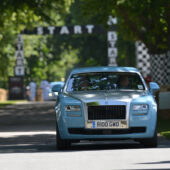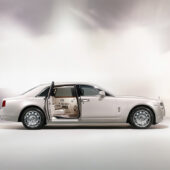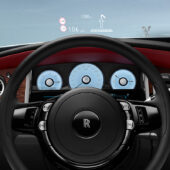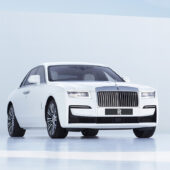Taking the fight back to Bentley and Mercedes, the Rolls-Royce Ghost used its BMW underpinnings to great effect. Here’s the full story
Words: Jon Burgess
It had not escaped Rolls-Royce’s parent company, BMW, that there was need for a cheaper car to sit below the Phantom. Not since the Silver Seraph left catalogues in 2002 had there been a junior Rolls-Royce with which attract new buyers, or retain long-term owners looking to downsize.
Once joined at the hip, Bentley (under the control of Volkswagen) and its Flying Spur were poaching otherwise affluent customers away from Rolls-Royce; these buyers, who may have been considering a second-hand Phantom, also had the long-wheelbase Audi A8 and Mercedes S-Class to consider. Then, of course, there was the elephant in the room: BMW’s own 760i with its twin-turbocharged 6.0-litre V12. Using this F01-generation car’s platform as a basis, Rolls-Royce’s new Ghost was born.
For its new car to use that particular name plate was ambitious. Originally the title of ‘Silver Ghost’ was given to the seminal London-Glasgow Reliability Trial 1907 40/50, ‘AX 201’; the moniker also appeared on later pre-war, wartime and post-First World War 40/50s, and not recognised officially by until 1925 when the Phantom range began.
Fittingly, the 2009 Ghost, known as RR04 within Rolls-Royce, was signed off by the seventh-generation Phantom’s chief engineer, Helmut Riedl. BMW, when pressed, admitted that around 20 per cent of RR04 was shared with the F01 7 Series.
Far from denigrating the Ghost, its shared heritage allowed BMW to get the car to market faster – with the 200EX Concept, shown March 2009 at the Geneva Motor Show, being a clear statement of intent. This was Rolls-Royce’s new car; by the end of the year, deliveries had begun to the UK and Europe, with Andreas Thurner (exterior) and Charles Coldham (interior) signing on a coach-doored saloon that acknowledged the seventh-generation Phantom.

Crucially, the Ghost’s engine had grown from 5972cc to 6592cc, with 563bhp and 575lb ft of torque on tap, driving through an eight-speed ZF automatic gearbox; the 760i’s unit was capped at 536bhp and 553lb ft. Concealment of the Spirit of Ecstasy was now done through the iDrive, but the Ghost retained the always-centred double-R wheel caps and umbrella holders in the doors.
By 2010, the rest of the world was receiving Ghosts, and a year later, buyers could also find an Extended Wheelbase model in catalogues, stretched by 170mm (6.69 inches) over the standard car.
BMW wasn’t sitting idle, however – by 2013, the ‘hard top’ coupe Wraith had joined the range; based on the Ghost, its rakish profile was unlike anything Rolls-Royce had built officially for decades, although hints of the 2013 one-off Phantom VII Coupe-based Sweeptail were redolent in profile.
2014 saw Ghost Series I production wind down – but not before a 35-car run of Alpine Trial Centenary Collection cars were built, all in sky blue with black grille and wheels – the colour scheme of James Radley’s Silver Ghost, ‘R-827’ that won the 1913 Alpine Reliability Trial in Austria. These final Ghost models also received an uprated ZF gearbox, known as satellite-aided transmission (SAT). Tied into the navigation system, the unit received Global Positioning Satellite co-ordinates to help work out what gear best suited the road, driving style, and throttle input.
Subtle differences marked out the Ghost IIs over their predecessors: a mild facelift had taken place, with the lozenge-shaped, Phantom VII-esque headlights of the Phantom VII replaced curvier units. N New alloys, reshaped bumpers and an uprated interior completed the transformation, though the Ghost Series II remained on the BMW F01 platform.

Extended Wheelbase production of the Series II got underway in short order; meanwhile, between January and June 2014, a limited-edition run of Ghosts, known as the V-Specification, celebrated five years since the appearance of the 200EX Concept which birthed the Ghost range. Power was upped from 563bhp to 592bhp and polished 21-inch wheels put the power down. Inside, ‘V’ motif graphics (V being the fifth Roman numeral) were engraved in the treadplates, rear armrests, and multimedia cover lid. A special clock also appeared in the dashboard, while on the outside, five shades from Royce’s 44,000 ‘ready to wear’ paint hues were recommended, though customers could, for a price, choose any colour they wanted.
A year after the Ghost Series II appeared, the Dawn convertible arrived at the 2015 Geneva Motor Show; sharing just 20 per cent in common with the Wraith, it added another string to the Ghost’s bow.
The V-Specification had hinted at the power the Ghost had to offer; by 2016, the model, together with the Wraith, had joined the Black Badge range, a sportier, more aggressive trim and performance specification designed to appeal to younger buyers. Most exterior trim – even the Rolls-Royce emblems – were black, while the with other brightwork tinted darker shades to go with the windows. There were new composite wheels, too, sat on aluminium hubs, connected to stronger driveshafts, stiffer suspension, and quicker steering. A reprogrammed, stronger ZF 8-speed automatic also held on to gears for longer, allowing for more aggressive driving than would usually be expected from a Rolls-Royce. The Ghost’s 6.6-litre V12 was remapped up to 595bhp – just a 3bhp increase over the limited-run V-Specification but up 32bhp on the standard car.
BMW was already gearing up to replace the Ghost with a successor by the same name, however. By 2019, as its Bespoke Collective paint, interior and décor division received a record number of patrons (which would be beaten consecutively in 2020 and 2021, against the Covid pandemic) Ghost Second Generation cars were spied testing.
The last of the F01-based Ghost Series II weren’t leaving without fanfare, however: the last 50 cars, known as the Zenith Collector’s Edition, featured special engravings, spread across all 50 units, and a small commemorative ingot cast from the Spirit of Ecstasy of the 200EX concept, meant to give the Ghost First Generation, in standard and Extended Wheelbase form, a fitting send-off.

Unlike Series I and Series II Ghosts, Ghost Second Generation sat on the scaleable aluminium and steel ‘Architecture of Luxury’ platform, which underpinned the Phantom VIII and Cullinan; Henry Cloke signed off the design. Ghost Second Generation models even received those cars’ 6.75-litre twin-turbo V12 engine, moving the name plate forward considerably in terms of derivation.
All-wheel-drive replaced rear-wheel drive on second-generation Ghost models, moving the model further away from its entry-level roots, with air suspension responsible for dealing with the road. Of course, Black Badge editions of the new Ghost weren’t far away. Said commissions quickly gained notoriety (and popularity) among Rolls-Royce buyers, representing 27 per cent of all models specified across the range (Wraith, Dawn, Phantom, Cullinan and, latterly, Ghost) by 2021.
45kg of black paint, with two layers of clear coat and a five-hour hand polish, together with a hand-painted coachline, defined the surfaces of the Ghost Black Badge Second Generation, but the Bespoke Collective could up the ante (and palette) if specified. Again, 692bhp was extracted from the 6.75-litre V12; 21-inch composite wheels, and stiffer suspension completed the mechanical package, with a ‘low’ mode on the gearbox to keep the engine in the boost threshold for longer.
The Rolls-Royce Ghost may have begun as the junior member of the range, but it can now be seen as a stepping-stone to a Phantom rather the gilded staircase the Series I and II cars represented.
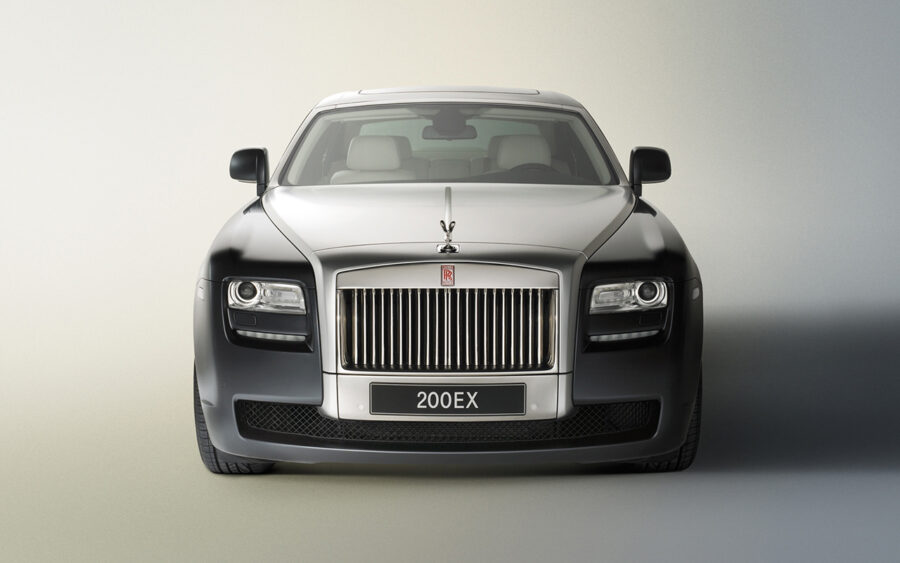
Rolls-Royce Ghost timeline
2009
200EX Concept (pictured above) – Ghost Series I in all but name – revealed at Geneva Motor Show. Production Ghost deliveries begin late 2009; 6.6-litre turbo V12 fitted. Car related to BMW 7-Series V12 (F01).
2011
Ghost Extended Wheelbase on sale.
2013
Ghost Series I derived ‘hardtop’ coupe, the Wraith – released.
2014
35-car Alpine Trial Centenary Collection limited edition sees off the Ghost Series I.
Ghost Series II launched.
Limited run Ghost V-Specification launched.
2015
Ghost Series II-derived Dawn convertible announced.
2016
Ghost and Wraith Black Badge released; gloss black paint, larger wheels, and a more powerful engine for ‘rebellious’ customers; Dawn goes on sale.

2017
Wraith Series II launched; Dawn Black Badge made available.
2019
Ghost Series II production winds down; special Zenith Collector’s Edition counts down the last 50 Series IIs.
2020
Ghost Second Generation launches in standard and Extended Wheelbase, now based on scaleable ‘Architecture of Luxury’ used on eighth-generation Phantom and Cullinan. V12 now up from 6.6-litres to 6.75-litres.
2021
Ghost Black Badge released with all-black detailing, larger wheels, and a power hike.











